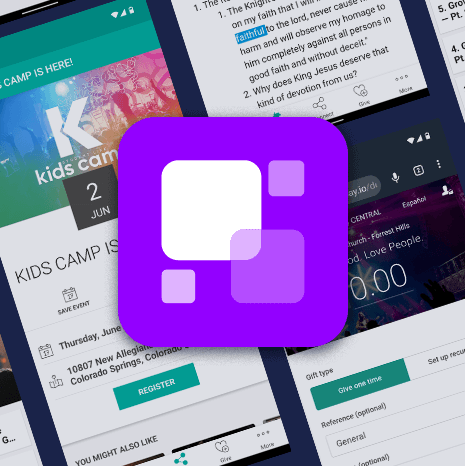How to Structure Your Church Media Department
April 1, 2024 |
At its core, the church media department serves as the bridge between the church’s mission and its members. This team not only manages the church communication strategy; they craft stories that resonate in the hearts and minds of the congregation.
In my journey, I’ve seen firsthand the power of a well-managed media team. From the early days of printed bulletins (which I believe still has its place in a communications strategy) to the dynamic world of online streaming services, each evolution has brought the church closer, made it more accessible, and deepened the relationship between congregant and their local church.
Defining the Scope and Responsibilities
The scope of a church media department extends far beyond what many might initially imagine. It encompasses everything from content creation and management to digital marketing, and community engagement through social media.
One of the most poignant lessons I’ve learned is that every piece of media we produce carries the potential to touch lives, to offer solace, and to inspire action. Whether it’s a thoughtfully crafted blog post, a heartfelt video testimony, promotion around an upcoming church event or a social media campaign, each element should be imbued with the sincerity and passion that define our faith in Jesus Christ.
Tour our
Apps Product
The mobile extension of your ministry. Only Pushpay offers a leader-only app in multiple languages.

Essential Roles and Job Descriptions of a Church Media Department
These positions can make sure your church media department structure is well-rounded:
Communications Director: At the helm of every team stands the Communications Director. This individual strategizes, plans, and oversees the execution of all media-related activities. They should be involved, in some form, in everything from the social media strategy to the design of the worship experience. Their role is not just administrative but profoundly creative and requires a deep understanding of both the technical side and the art of storytelling.
Audio/Visual Technician: The unsung heroes of our worship services, Audio/Visual Technicians ensure that every sermon, song, and prayer is delivered seamlessly. Their expertise transforms physical spaces into sanctuaries of sound and light, allowing the spirit of your gatherings to resonate both in-person and online. Their work is a blend of art and science, making the divine accessible through technology.
Social Media Coordinator: This person serves as the voice across all social media platforms. They craft messages that invite engagement, foster community, and inspire reflection. Through posts, videos, and livestreams, they extend your church’s reach far beyond your four walls.
Graphic Designer: With every design and piece of content, these creatives tell your story visually. Be it through website graphics, newsletters, or digital banners, their work touches everything that the congregation sees. (For churches that can’t afford individual graphic designers, I’ve had a really great experience with Church Media Squad!)
Volunteer vs. Paid Staff
Once the positions of your church media department are laid out, you can begin to evaluate whether you need to hire new team members or if you should look within your church body for volunteers.
Volunteers, with their diverse talents and unwavering commitment, are the lifeblood of our operations. They offer their time and skills out of a deep sense of calling and service, enriching your efforts with personal experiences and perspectives.
Paid staff, on the other hand, provide consistency and professional expertise that elevate your media endeavors. Their dedication ensures that the strategic vision of the media department is continuously pursued, maintaining high standards of quality and innovation.
Balancing the Two: Finding harmony between volunteers and paid staff involves recognizing the value and limitations of each. It’s about creating an environment where everyone feels valued, supported, and inspired. By offering training and development opportunities, we empower our volunteers, fostering a sense of ownership and pride in their contributions. For your paid staff, providing clear roles and expectations, along with fostering a culture of mentorship, ensures that their professional goals and the church’s mission align.
This balance is not without its challenges. Yet, it is within these challenges that we find growth. By embracing the diverse talents within our community, you not only enhance your media ministry but strengthen the bonds that unites a congregation. It’s a delicate dance of gratitude and guidance, where each step forward is taken together, hand in hand.
Training and Skill Development
Once you’ve welcomed new members into the fold, the focus shifts to nurturing their talents and fostering their growth. The journey of skill development is both a personal and communal endeavor and it reflects our dedication to excellence.
Offer Tailored Training: Recognizing that each individual brings unique strengths and areas for growth, tailored training programs are essential. Whether it’s technical skills, creative expression, or spiritual grounding, providing resources and opportunities for development speaks to your investment in each team member’s development.
Promote Continuous Learning: In the ever-evolving landscape of media, staying abreast of trends and technologies is vital. Encouraging a culture of continuous learning and curiosity not only enhances our team’s capabilities but also keeps our message vibrant and relevant.
Encourage Mentorship: The bonds formed through mentorship are the threads that strengthen the fabric of your team. By pairing experienced members with newcomers, you create a nurturing environment where knowledge is shared, confidence is built, and the sense of belonging deepens.
Each person on your media ministry team is, in some shape or form, a church leader—it’s important to perceive them as such.
Investing in the Right Technology for Your Church Media Department
Understanding Needs: Do you need to store your media content (sermons, Bible studies, podcasts, etc.) somewhere easily accessible? Are you looking for a way to communicate with your church quickly and concisely? These are the types of questions you must ask as you evaluate the technology that we currently have.
Quality Over Quantity: In a world brimming with endless technological options, it’s easy to feel overwhelmed. Yet, I’ve found that focusing on quality over quantity not only simplifies choices, but elevates their impact. Selecting a few, well-suited platforms allows you to craft messages that are not just heard but felt.
Future-Proofing The Mission: Reflecting on my own experiences, I’ve come to appreciate the importance of forward-thinking in our technological investments. Choosing platforms and tools that are adaptable and scalable ensures that as your congregation grows and evolves, so too will your ability to connect and inspire.
Conclusion
The journey of blending technology and media into your ministry isn’t just about adopting new tools or shaping messages; it’s about deepening connections to each other and the divine call guiding us. Our media strategy and tech choices are all rooted in our shared mission and defining values. Each decision we make, from content sharing to platform selection, is a testament to our faithfulness, outreach dedication, and unwavering belief in the effectiveness of the local church.
Church Tech
Buyer’s Guide
Learn how to evaluate church tech needs and make the best buying decisions.

Featured Content
You May Also Like


